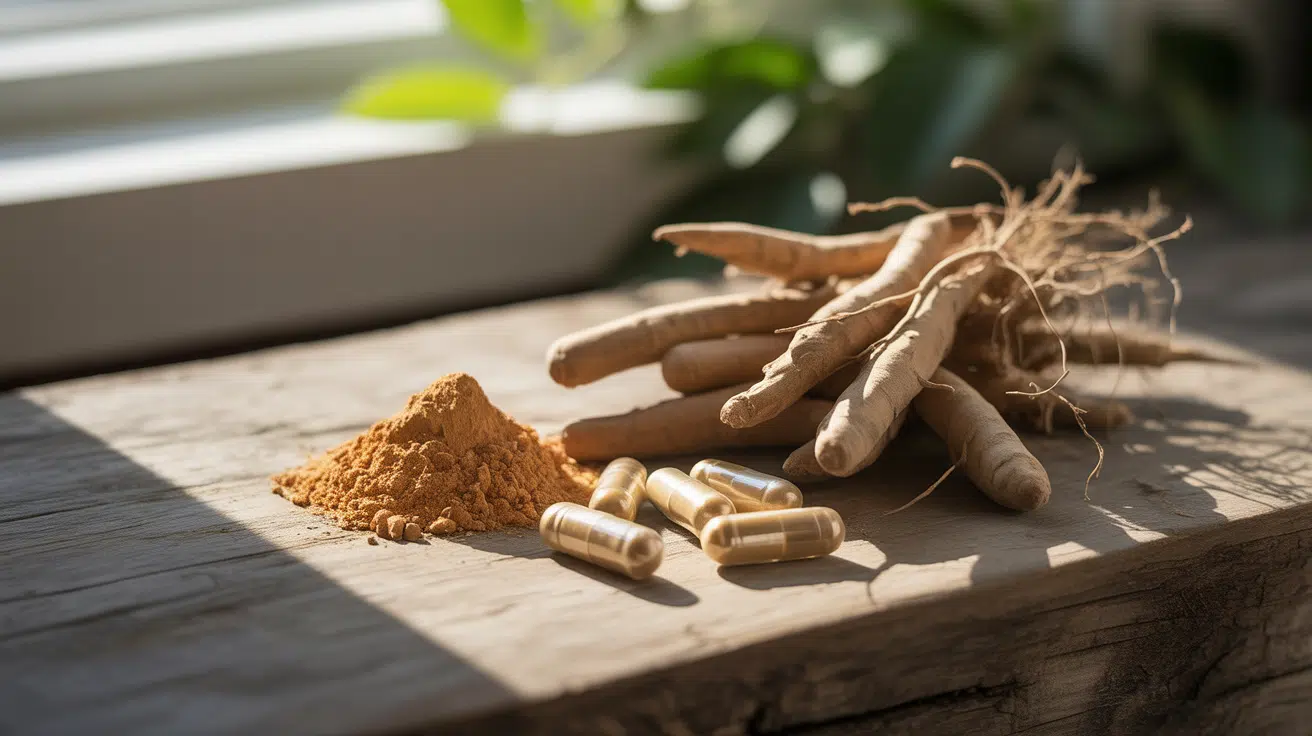You’ve probably heard about ashwagandha and its calming, stress-reducing benefits, but you might still be wondering, “How long does it take for ashwagandha to work?”
If you’re using it to help with stress, anxiety, or sleep, it’s important to set realistic expectations from the start. I’ve found that ashwagandha isn’t something that works instantly; it’s a supplement that builds its effects over time.
In the next few minutes, you’ll see what kind of timeline you can expect, why the process is gradual, and how you can give yourself the best chance of noticing lasting improvements.
Understanding Ashwagandha
Ashwagandha is a traditional Ayurvedic herb valued for its adaptogenic properties, helping the body manage stress and restore balance naturally.
| Attribute | Details |
|---|---|
| Scientific Name | Withania somnifera |
| Common Names | Ashwagandha, Indian ginseng |
| Origin | Over 3,000 years ago, part of Ayurvedic medicine |
| Class | Adaptogens |
| Forms Available | Capsules, powders, liquid extracts, teas |
| Bioactive Compounds | Withanolides |
Ashwagandha’s bioactive compounds work gradually to support physical, mental, and emotional health, making it a versatile wellness supplement.
How Long Does It Take for Ashwagandha to Work?
Most people begin noticing ashwagandha’s effects within 2–4 weeks of regular use, though timelines can vary. If you’re wondering if ashwagandha works right away, the answer is no. It works gradually, with benefits building over time.
Unlike caffeine or prescription medications, its effects are more like a vitamin supplement, compounding with consistent use.
Ashwagandha’s active compounds, withanolides, work at the cellular level to balance cortisol, improve neurotransmitter function, and strengthen your stress response.
For anxiety and stress, changes in mood and resilience develop over several weeks, with the most noticeable benefits often appearing after one to two months. Daily, consistent use is key for lasting results.
Factors That Affect Your Timeline


Several key factors influence how quickly ashwagandha works, from dosage and form to lifestyle habits and timing of intake.
1. Dosage & Standardization
The amount of ashwagandha you take and its potency directly affect results. Standardized extracts list withanolide content, the active compounds responsible for benefits. Higher doses within safe limits may lead to faster effects, while low or inconsistent dosing can delay changes.
Always check product labels for standardization (often 5% withanolides) to ensure consistent potency. Following clinical guidelines, such as 300–600 mg daily, can help you achieve results more predictably without exceeding safe intake levels.
2. Consistency of Use
Ashwagandha works gradually, so daily intake is essential for noticeable results. Skipping doses can slow progress and reduce benefits. Just like vitamins, its effects build over time, meaning consistency matters more than occasional high doses.
Choose a form and routine that fits seamlessly into your day to make it easy to stay on track. Setting reminders or pairing it with a regular meal can help ensure you take it regularly enough for your body to respond.
3. Form (Capsules, Powder, Liquid)
Different forms of ashwagandha may be absorbed at different rates. Powders mix easily into drinks and can be quickly absorbed, liquid extracts are highly concentrated and convenient for fast absorption, while capsules offer portability and precise dosing.
Your choice should depend on preference, lifestyle, and ease of daily use. If faster absorption is a priority, liquids and powders may have a slight advantage, but the key is picking a form you can take consistently without missing doses.
4. Timing (Morning vs. Night)
The time you take ashwagandha can affect how quickly you notice certain benefits. Morning doses may support daytime calm and stress control, while evening doses can promote better sleep. Some users split their dosage to balance both effects.
Whatever you choose, taking it at the same time daily helps maintain steady levels in your body. Consistent timing can improve the compound’s long-term impact on mood, energy, and relaxation, making your results more predictable and sustainable over time.
5. Individual Lifestyle/Health Factors
Your overall health, diet, stress levels, and sleep habits all influence how quickly ashwagandha works. People with healthier lifestyles often notice benefits sooner because their bodies can respond more effectively.
High stress, poor sleep, or nutrient deficiencies may slow progress. Existing health conditions and medications can also impact results, so it’s important to consider your unique circumstances.
Combining ashwagandha with supportive lifestyle changes, like exercise, balanced eating, and mindfulness, can help you see faster and more lasting improvements.
Progress Timeline: Short- to Long-Term Effects
| Time Frame | Common Effects |
|---|---|
| Week 1–2 | Subtle calmness, slightly improved sleep, small mood shifts, reduced irritability (especially for anxiety and stress). |
| Weeks 3–4 | Noticeable reduction in daily stress and anxiety; greater emotional balance and resilience during challenges. |
| Weeks 6–8 | Significant, steady calmness; stronger sense of control over stress triggers. |
| Weeks 9–12 | Peak sustained benefits: long-term mood stability, improved stress management, and overall emotional well-being. |
How to Get Results Faster with Ashwagandha?
Making small, intentional adjustments to how you take ashwagandha can help you notice benefits sooner and maintain them longer.
1. Choose the Right Form
Ashwagandha comes in powders, capsules, and liquid extracts, and each has different absorption rates. Powders can be mixed into drinks, capsules offer convenience, and liquid extracts are highly concentrated.
Choose the form that best fits your daily routine so you can take it consistently. If faster absorption is your priority, powders and liquid extracts may work slightly quicker than capsules, though consistency matters more than the form alone.
2. Find Your Dosage
Most people benefit from 300–600 mg of standardized ashwagandha root extract daily, but starting low helps gauge your body’s response. Begin with a smaller dose, such as 300 mg, and gradually increase if needed after one to two weeks.
This approach can reduce the risk of side effects while giving your system time to adjust. Always check product labels for withanolide content and consult a healthcare provider if you’re unsure about the right dosage for your needs.
3. Best Time to Take It
The ideal time to take ashwagandha depends on your goals. If you want daytime calm and better stress control, morning doses work well. For improved sleep quality, consider taking it in the evening.
Some people split their dosage between morning and night for balanced effects. Whichever time you choose, aim to take it at the same time daily to maintain steady levels in your system and maximize potential benefits over the long term.
4. Support With Lifestyle
Ashwagandha works best when paired with healthy daily habits. Good sleep hygiene, balanced nutrition, regular exercise, and mindfulness practices like meditation can improve its reduce its effects.
A consistent bedtime, a nutrient-rich diet, and physical activity help your body respond more positively to the herb. These habits support your nervous system and hormonal balance, allowing ashwagandha’s active compounds to work more effectively.
Think of the supplement as part of a broader approach to long-term wellness rather than a stand-alone solution.
5. Optional Adaptogen Combos
Combining ashwagandha with other adaptogens may offer added benefits. Rhodiola can boost energy and focus, while Holy Basil supports stress management and immune health. Always introduce one new supplement at a time to monitor how your body responds.
Adaptogen blends can be convenient, but check for standardized extracts and reputable sourcing. While combinations can be effective, ensure they don’t interfere with your health conditions or medications by consulting a healthcare professional before making significant changes to your supplement routine.
What If You Don’t Notice Changes?
If you’ve been taking ashwagandha consistently for several weeks without noticing improvements, start by reviewing your dosage and the form you’re using. Some people respond better to a different form, such as switching from capsules to liquid extract or powder.
Adjusting the timing can also make a difference, try morning for daytime calm or evening for better sleep support. If you still don’t see results after 8–12 weeks, consult a healthcare provider.
They can help determine whether dosage adjustments, alternative adaptogens, or other approaches may be more effective for your specific needs and overall health goals.
Who Should Avoid Ashwagandha?


Certain people should avoid ashwagandha due to its effects on hormones, the immune system, and possible medication interactions.
Pregnant or breastfeeding women should avoid it, as it may affect pregnancy outcomes.
People with autoimmune disorders like lupus or rheumatoid arthritis should be cautious, as it may stimulate immune activity. Those with thyroid issues could see altered hormone levels.
Individuals on medications for blood sugar, blood pressure, or immune suppression may face interactions. Those with hormone-sensitive conditions should consult a healthcare provider before use.
Choosing a Good Ashwagandha Supplement
Picking the right ashwagandha supplement ensures safety, potency, and effectiveness, helping you experience its benefits more consistently and predictably.
- Look for third-party testing to confirm purity and potency.
- Choose standardized extracts with clearly stated withanolide percentages.
- Opt for GMP-certified brands with NSF or USP certifications for safety.
- Prefer root extracts over leaf extracts for proven benefits.
- Select reputable brands like KSM-66 or Sensoril.
- Consider capsules or powders for better value and potency.
- Avoid unclear labels and supplements with fillers, artificial colors, or additives.
Conclusion
If you’ve been curious about how long it takes for ashwagandha to work, the main thing to remember is that its benefits build slowly but steadily.
With daily use, you may notice small changes in a couple of weeks and more consistent improvements after a month or two. The key is patience, consistency, and choosing a quality supplement that fits your needs.
If you’re ready to start, track how you feel along the way so you can see the difference over time. You might also want to find my other blogs on natural stress support to help you create a balanced wellness routine.










